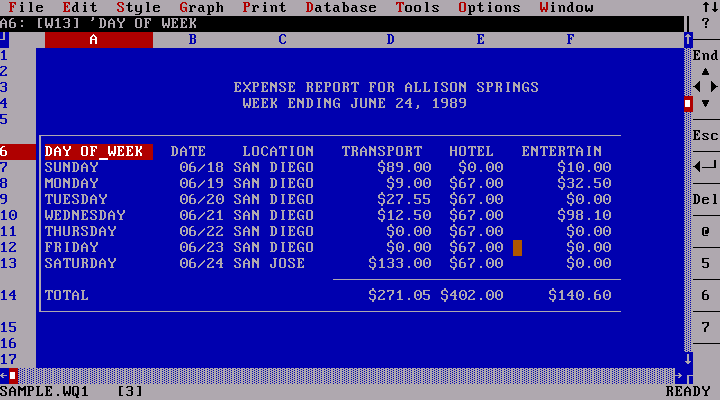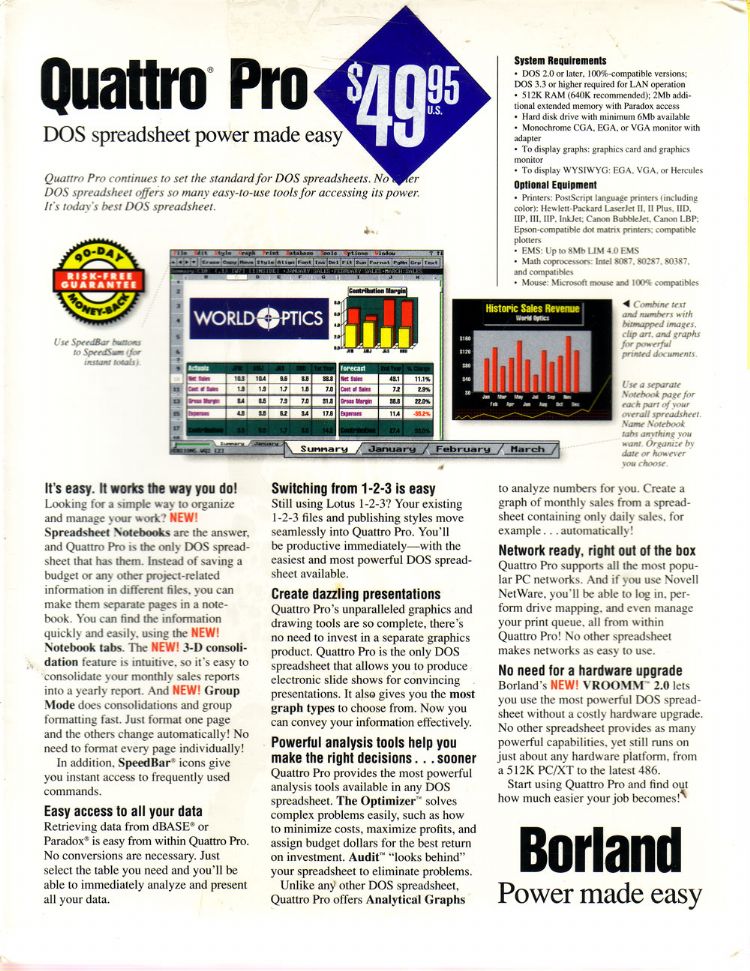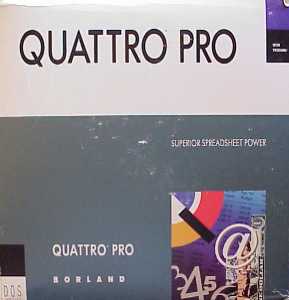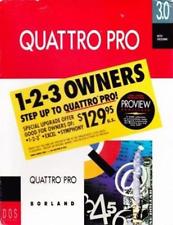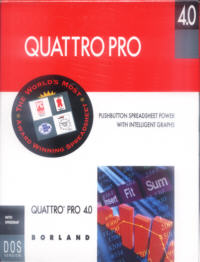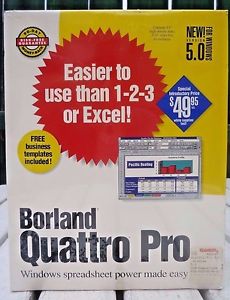Borland International, Inc.
Quattro
In 1988, Borland launched their first spreadsheet to rival the then market leader, Lotus 1-2-3. When version 1.0 was in development, it was codenamed "Buddha" since it was meant to "assume the Lotus position". The name Quattro was devised since quattro, meaning four, was the next number after 1-2-3. Quattro was written in assembly language and Turbo C principally by Adam Bosworth, Lajos Frank, and Chuck Batterman.
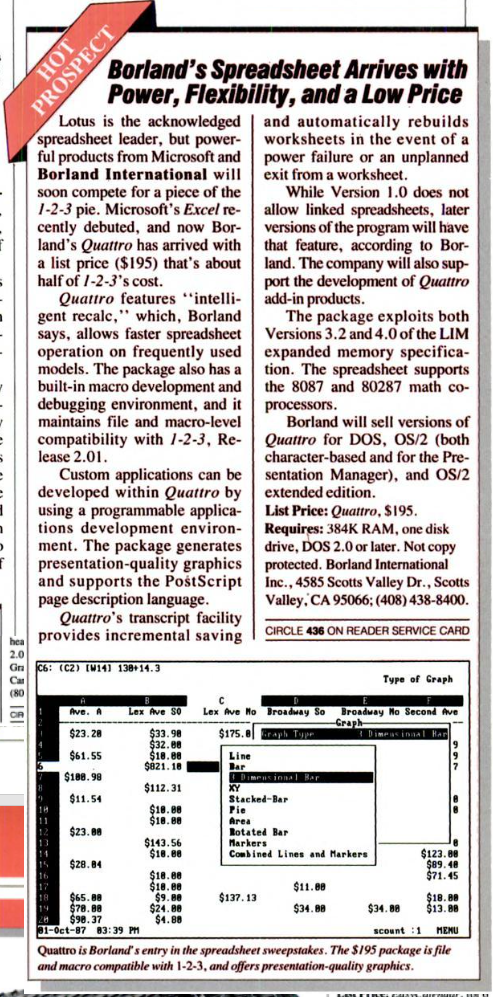
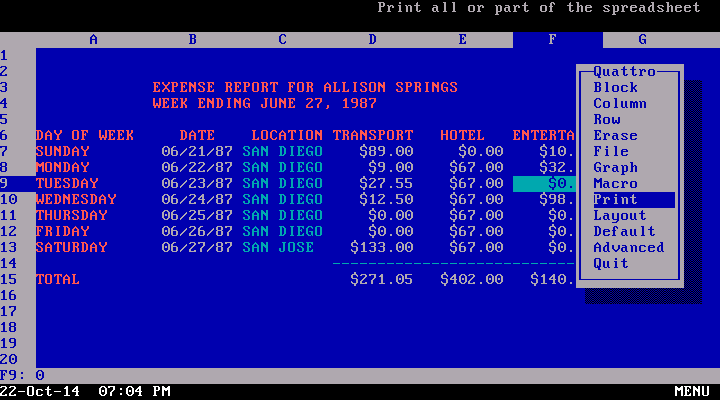

(Left) a preview of Quattro in PC Magazine dated 24th November 1987, and
(Centre) screenshot of Quattro 1.0
(Right) a Quattro advert, also in PC Magazine dated 24th November 1987
Quattro Pro
In January 1988, Borland acquired a company called Farsight Software who sold a product called "Surpass". This product had a feature set that outweighed all other spreadsheets including Borland's own. Instead of rebranding this existing product, Borland mistakenly decided to port the code from Surpass' native Modula-2 language into Turbo Pascal. This was under the belief that Turbo Pascal was a superior development system to the STS-XP used in the development of Surpass. In reality, the final result was a much slower product than Surpass was. This delayed Quattro Pro's launch for more than a year, being finally released in late 1989 instead of mid to late 1988. Sales were buoyant, however, with more than 100 million USD of sales in under a year. This really put pressure on Lotus with their rival 1-2-3 product at the time.
Quattro Pro 2.0
Version 2.0 was unveiled in September 1990, enhancing the program's graphical features and analytics. It included a "Solve For" capability for what-if analyses, as well as improved presentation capabilities and tight links to Paradox 3.5 databases. Bundled with 2.0 for new customers was Proshow Power Pack which includes a clip-art selection, macro library and additional fonts. The list price was $495 for new customers, $79.95 for existing customers looking to upgrade, or $99.95 for owners of competitive spreadsheets. The Power Pack cost an additional $39.95 for those upgrading.
The Lawsuit with Lotus
Quattro Pro was the subject of a major lawsuit by Lotus against Borland. Lotus argued that Quattro could not copy Lotus 1-2-3 menus (it did copy the menus). Borland supplied the 1-2-3 menus as an alternative because keystroke compatibility was needed in order to run macros in 1-2-3 worksheets. Borland argued that most cars operate the same, but they are not necessarily made the same. So, Lotus could not rationally "own" the way its program behaved. The district court ruled in favor of Lotus, but the appellate court ruled that the 1-2-3 menus were functional and not copyrightable. The case went all the way to the U.S. Supreme Court which split 4 to 4. This left the lower court ruling intact, which was a victory for Borland. However, the broader issue of whether a company can own and protect the way its program behaves remained unresolved. By the time the case was resolved, Borland no longer owned Quattro Pro. Borland sold the spreadsheet to Novell six months before the final decision was handed down.
Quattro Pro 3.0
By 1991 Quattro was on the brink of taking over 1-2-3's position as the clear market leader and the de facto standard for doing spreadsheets on PCs. In the middle of this year, while its first Windows version was still under development, Borland launched Quattro Pro 3.0 for DOS. The centrepiece of v3.0 was its WYSIWYG ("What You See Is What You Get") graphical display option. This was similar to Lotus 1-2-3's graphical publishing add-in from PC Publishing called Impress, and completely replaced Quattro Pro 2.0's "Graphics Display" option. The new mode showed fonts in their relative sizes and shapes and gave an accurate representation of underscores and borders.
Version 3.01 arrived in June 1991 as a 'maintenance upgrade', significantly improving screen redraw performance on 8088 and 80286 systems, after user complaints came in. It was given to existing Quattro Pro 3.0 users for free.
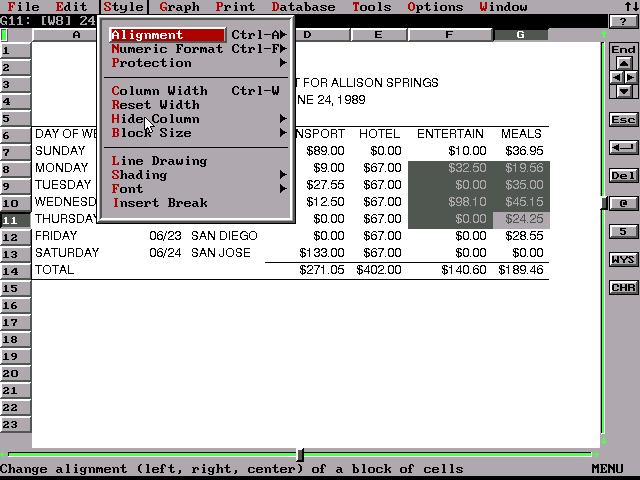
Quattro Pro 3.01 in WYSIWYG mode
Other highlights included a host of printing improvements, better alignment features, 3D sculpted buttons and other objects in the Annotator, and visual and aural transition effects for slide shows. Furthermore, an auto-save feature meant that every change in numerical data would automatically update the graph.
In November 1991, Borland introduced a limited-time offer whereby if you bought either Quattro Pro 3.0 or Paradox 3.5 you would get two more products absolutely free. The other products were Borland Sidekick 2.0, Quarterdeck QEMM-386 v6, or Central Point Backup 7.1 for Windows and DOS.
Quattro Pro 4.0
By early 1992, Borland had completed
work on version 4.0. This version was again advertised with aggressive marketing against Lotus 1-2-3, with Borland claiming that a usability study had found that four out of five 1-2-3 users preferred Quattro Pro. Version 4.0 removed the old 1-2-3 menu system (accessed via the forward slash key), keeping just the native Quattro one, and included what they dubbed "pushbutton power" - this included the new "SpeedBar" - a row of clearly labelled buttons that gave access to commonly used features and macros.
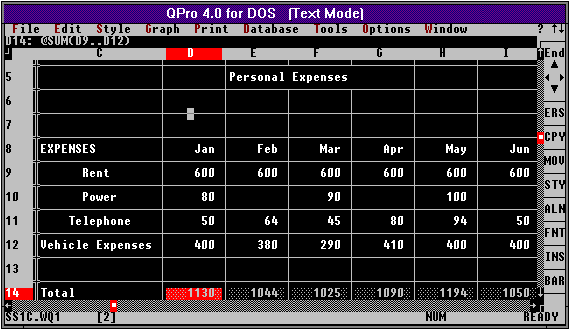
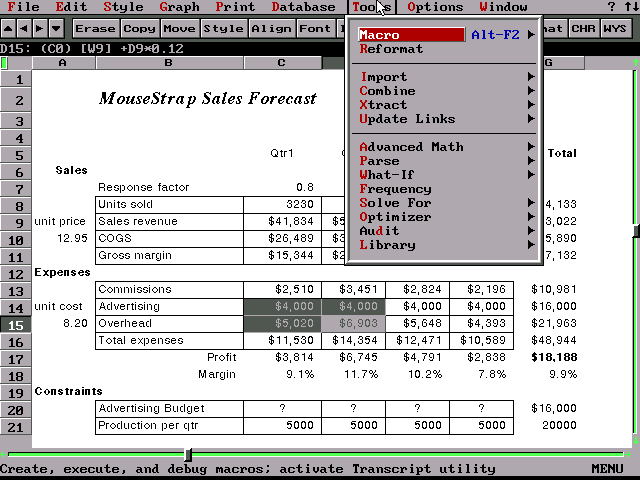
Quattro Pro 4.0 in text mode and WYSIWYG mode
"Intelligent Graphs" now allowed you to perform extended analysis on your graphs without changing the underlying data, and 4.0 also incorporated Novell Netware integration such as automatic logon, mapping drives, and print queue monitoring.
Quattro Pro for Windows and v5.0 for DOS
Quattro Pro began as a DOS program (like Lotus 1-2-3) but with the growing popularity of Windows from Microsoft, a Windows version of Quattro needed to be written. There was almost nothing from the DOS code that could be moved to the Windows project, so Quattro Pro for Windows (QPW) was written from scratch.
The Lotus vs Borland battle for #1 spreadsheet was interrupted by the exploding sales of Microsoft's Excel. It is very likely looking back that if the year's delay to get Quattro Pro on the shelves had not come about, Quattro Pro would have been the market leader, and Borland's Windows version would have been released sooner, at a time when there was no other spreadsheet for Windows.
Quattro Pro for Windows was finally released in September 1992. The marketing team had chosen to bundle both Quattro Pro for DOS and Quattro Pro for Windows in the same box labeled "WIN-DOS" at a price of $495. At this time, Microsoft Excel along with the Office suite was still in its infancy. Borland made a version numbering jump from 2.0 up to 5.0, skipping out 3.0 and 4.0. This was done for marketing reasons - it aligned the Windows version of the product with its DOS counterpart, and because Lotus and Microsoft were already at version 4, Borland didn't want to risk the perception that a Quattro Pro 3.0 was a generation behind its rivals.
Quattro Pro 5.0 for Windows was introduced in August 1993, a few months after Lotus released 1-2-3 Release 4.0, and a few months ahead of the next major update to Microsoft Excel. This version took the concept of "three-dimensional worksheets" to the next level with the addition of analytical tools to give users a deeper understanding of their data. This version's code was also based on object-orientation just as with other Borland products - by clicking on a mouse a command menu would appear with tutorials and help screens, along with a new "expert" feature that showed the user how to perform common spreadsheet tasks. It went on sale in September at an aggressive price of $49.95 - one tenth the cost of Lotus 1-2-3 and Excel. For anyone upgrading from a previous version the price was even cheaper - $39.95. This was even extended to customers prepared to switch from a rival program!
At the same time the final release for DOS came out. This added 3D notebooks, further network capabilities, and style formatting also now worked in text mode.
A number of file formats have been used to store Quattro [Pro] spreadsheets. From versions 1.0 through 4.0, the .WQ1 file extension was given to a spreadsheet file. For Quattro Pro 5.0 and 5.5, the .WQ2 extension was used. Support to read these files was included in Microsoft Excel from v3.0 right up to Excel 2007.
All versions up to and including 4.0 as well as the "Special Edition" (SE) can be run on an 8088/8086 PC with 512 KB RAM and monochrome monitor. WYSIWYG mode requires an EGA or VGA monitor. Version 5.6 requires an 80386 CPU as a minimum.
Below you'll find some box art for the DOS versions of Quattro Pro from version 1.0 up to 5.0.
